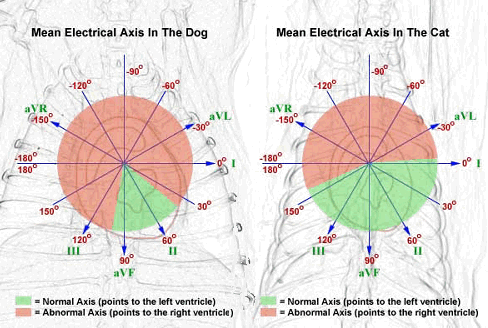The mean electrical axis (MEA) of the QRS complex (determined in the frontal plane) represents the net or average direction of activation of the entire ventricular myocardium.

There are three common methods of calculating the MEA in the frontal plane: the vector method, the isoelectric method, and the greatest net deflection method. All of these are merely approximations.
The isoelectric method or the greatest net deflection method are easiest and are described below. Examples will be performed in lab.
- The Isoelectric Method: Find the lead, of the 6 leads in the frontal plane, that is the most isoelectric (the algebraic sum of all the deflections of the QRS in that lead comes closest to zero) (again omit the T wave). Next, find the lead on the frontal plane diagram that is perpendicular to this isoelectric lead (the MEA will lie along this perpendicular lead). Note the net polarity of the complexes in this perpendicular lead. If the net polarity of these complexes is positive, the MEA is toward the positive pole of the perpendicular lead; if the net polarity of these complexes is negative, the MEA is toward the negative pole of the perpendicular lead.
- The Largest Net Deflection Method: Find the lead, of the 6 leads in the frontal plane, that contains the QRS complex with the largest net deflection (the algebraic sum of all the deflections of the QRS in that lead is the largest value [positive or negative]). The MEA will lie along this lead. If this largest net deflection is positive, the MEA is toward the positive pole of this lead with the largest net deflection; if this largest net deflection is negative, the MEA is toward the negative pole of this lead with the largest net deflection.
Determining the MEA is very useful to identify right ventricular enlargement. A MEA of 100 to -75 degrees in the dog or 160 to -75 degrees in the cat suggests right ventricular enlargement.
The MEA also helps determine the nature of aberrant conduction disturbances (so called bundle branch block).
